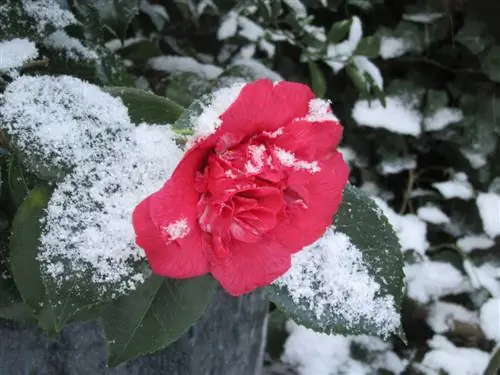- Author admin [email protected].
- Public 2023-12-16 16:46.
- Last modified 2025-01-23 11:20.
With a height of up to eighty centimeters and orange-red, brightly colored flower heads, the marigold is one of the most popular ornamental flowers in the garden. But unfortunately the most beautiful garden summer will eventually come to an end and winter is approaching.

Are marigolds hardy?
Tagetes, also known as marigolds, are not hardy because they come from warmer regions of South America. They can be brought indoors to overwinter, at temperatures of 15-20°C and with sparing watering. Alternatively, you can grow them from seeds.
The marigold is not hardy
The wild forms of marigolds thrive on the hot slopes of South America, where temperatures never fall below freezing, even in the cold season. That's why most hybrids cultivated in our gardens are not frost-resistant and are grown as annual garden plants. Since the marigold is perennial, you can maintain particularly beautiful specimens indoors during the winter.
Overwintering the marigolds
It is important to bring the plant into the house in good time. Unfortunately, if it has already been damaged by frost, it often collapses. Carefully dig up the marigold and plant it in a pot filled with potting soil.
Place this in a bright, frost-free but not too warm room. Temperatures between 15 and 20 degrees are ideal. Since the marigold is dormant during the winter, the marigold should be watered sparingly and not fertilized.
More promising: breeding from seeds
Since Tagetes produces many easily germinating seeds, it is easier to grow the pretty flowering plant yourself every year and transplant it into the garden after the Ice Saints. Often the marigold even self-fertilizes and germinates without any further action, so that you will find many small marigold plants in the bed the following spring.
Harvesting seeds
It is important not to cut off everything that has faded so that the seeds can ripen in the flower heads. Once the flowers have dried, they are carefully snapped off and left to dry completely on a piece of kitchen paper. If you only need a small amount of seeds, you can pull the seeds out of the pods individually. If the demand is higher, this work is quite laborious.
In this case, put the dried flowers in a plastic bag, inflate it slightly and seal it. Shake vigorously to loosen the seeds from the inflorescences. Now pour everything into a sieve with holes that are too small. The seeds fall through the holes and can now be stored, well packaged in paper bags, until next summer.
Tip
Tagetes are not just pretty to look at. At the same time, they serve to improve the soil because they kill harmful nematodes in an ecological way.






